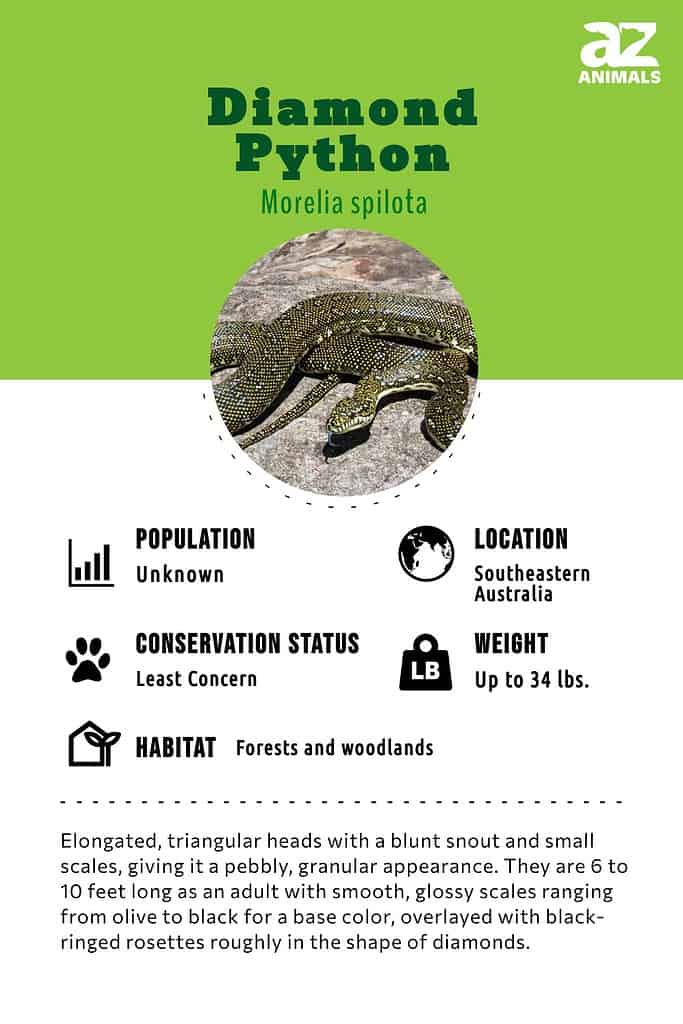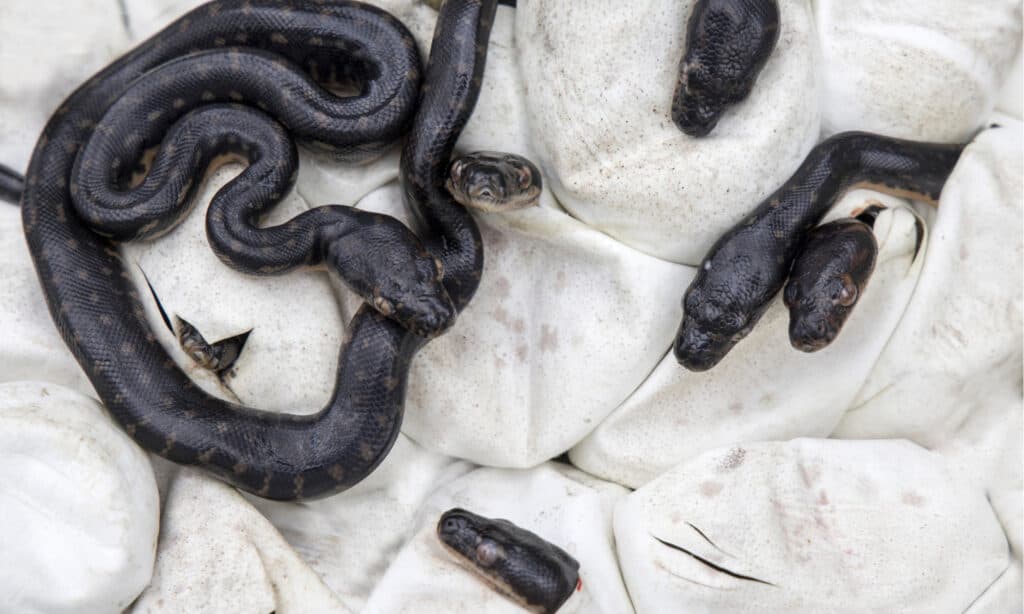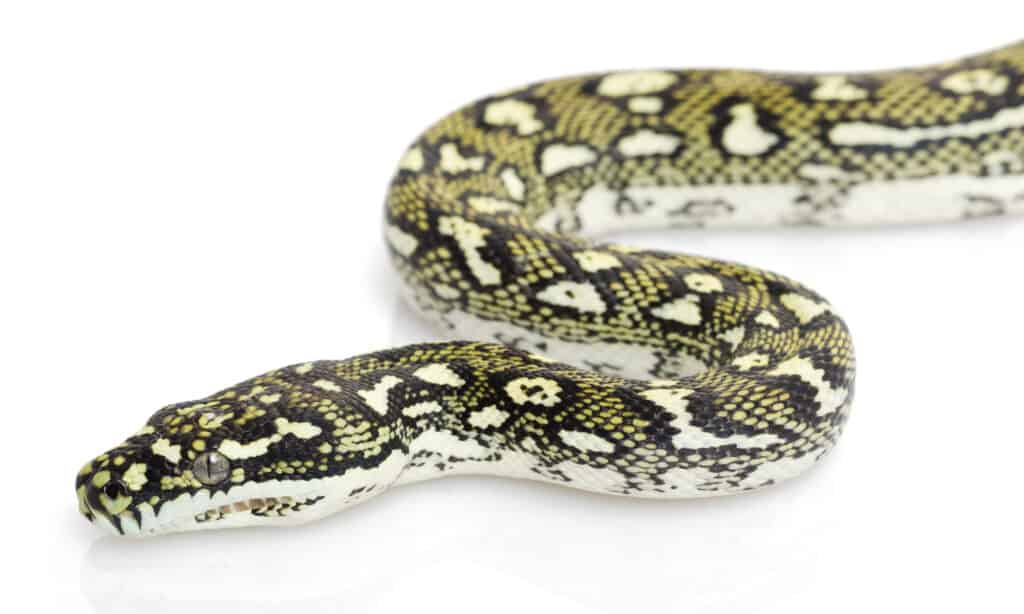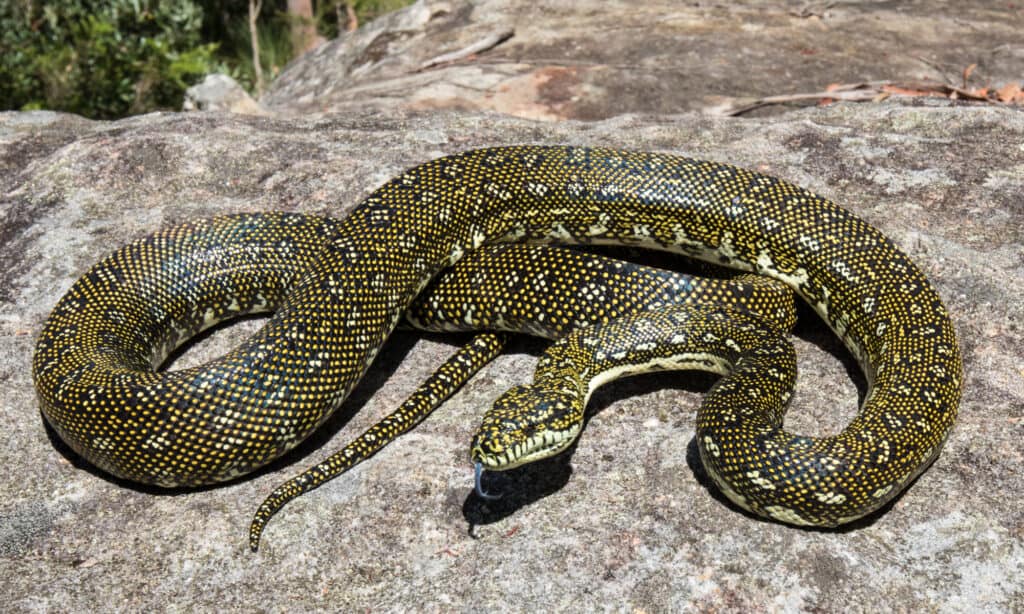Diamond Python
These pythons live at higher altitudes and further south than any other python species.
Advertisement
Diamond Python Scientific Classification
- Kingdom
- Animalia
Read our Complete Guide to Classification of Animals.
Diamond Python Conservation Status
Diamond Python Facts
- Prey
- mice, rats, possums, birds, lizards, frogs
- Main Prey
- Rodents including mice and rats.
- Group Behavior
- Solitary except during mating season
- Fun Fact
- These pythons live at higher altitudes and further south than any other python species.
- Biggest Threat
- Habitat loss
- Most Distinctive Feature
- Diamond-shaped rosettes in their pattern
- Other Name(s)
- diamond carpet python
- Litter Size
- up to 54
- Average Litter Size
- 25
- Lifestyle
- Nocturnal
- Diurnal
- Location
- Southeastern Australia
Diamond Python Physical Characteristics
- Color
- Brown
- Yellow
- Fawn
- Black
- White
- Tan
- Green
- Dark Brown
- Cream
- Skin Type
- Scales
- Lifespan
- 20+ years
- Length
- 6.5-10 feet
- Age of Sexual Maturity
- 3-5 years
- Venomous
- No
- Aggression
- Low
View all of the Diamond Python images!
The diamond python is a subspecies of carpet python that occurs in southeastern Australia near the coast.
While its native environment includes forests with trees to climb, this semi-arboreal snake is often found near human settlements. It is versatile and found in attic crawl spaces and other rooftop locales slithering about looking for rats and possums.
Amazing Facts About Diamond Pythons
- Its native range is the furthest south of any python species, and of the Australian pythons, which occur at the highest altitudes.
- While they are docile and not inclined to bite, if harassed, they bite hard. Sometimes a tooth breaks off in the wound.
- Captive-bred individuals sometimes experience a loss of muscle mass. No one knows what causes it, but some suspect it has to do with inappropriate temperature ranges.

Where to find Them
Diamond pythons inhabit the southeastern coastal areas of Victoria and New South Wales in Australia. They are adaptable snakes and are comfortable living in forests, heaths, and urban areas. These snakes often live in attics, wall spaces, rafters, and on the roofs of homes in urban and suburban neighborhoods.
This subspecies is often found in the Blue Mountains – higher than any other Pythonidae family member. Its native range is also the furthest south of any other python species. Its temperature needs tend to be lower than that of other pythons too, a direct result of its southern range.
During the summer, diamond pythons move around their territories which can range from 120 to 240 acres. Males’ territory is larger than females by almost double, and many territories overlap.

Diamond pythons are comfortable living in forests, heaths, and urban areas.
©Ferdy Timmerman/Shutterstock.com
Diamond pythons are often active on warm nights and during the day. Even so, they are primarily ambush predators. They sit motionless for days on end, waiting for an opportunity to strike at a meal. A snake may stay in one place for a few weeks, then move on to another location only a hundred yards from the first. They eat various animals including rodents, possums, birds, and lizards.
Reproduction
These snakes sometimes cross-breed with another closely related carpet python subspecies, the coastal carpet python (Morelia s. mcdowelli). Natural intergrades of the two subspecies have been found in New South Wales on the mid-north coast.
Mating occurs between September and October, and the snakes are pretty secretive during this process. They often find a secluded little den to mate, and only come out to bask. After mating and about three weeks before she lays the eggs, the female goes through a shed. She may lay up to 54 eggs and defends them until the eggs hatch. She coils around them and shivers periodically to help keep the temperature consistent. The only time she leaves the eggs is to bask for a short while to warm up.

Females can lay up to 54 eggs that hatch about 55 days later.
©Ken Griffiths/Shutterstock.com
Baby diamond pythons hatch after about 55 days of incubation. They look like miniature versions of the parents, with the exception that they have a more brown coloration that will brighten up to olive or darken to a black base color.
Scientific Name and Classification
Scientifically speaking, diamond pythons go by the name Morelia spilota spilota. They are the nominate subspecies of the group, which means that they were the first described by scientists. They get their common name from the diamond-shaped rosettes in their pattern. These snakes are also called carpet pythons and diamond carpet pythons.
The differences between the various M. spilota subspecies are relatively small and mostly amount to localities with differences in colors, patterns, and preferences.
History and Evolution
Just like other snake species of snakes, the python’s predecessors were also reptiles but with legs. These animals were more aquatic-based. Snakes either lost their legs or became vestigial, as they became more and more unused. It is interesting to imagine animals evolving to have legs and then evolving to lose them! As these snakes adapted to living as low to the ground as they can to avoid enemies and be closer to their prey.
Pythons were previously classified with boas, but modern research has shown that the pythons and boas are separate species due to convergent evolution in different parts of the world, much like monkeys evolved differently in Africa and South America while having shared ancestors. Some of the major differences are that boas give birth to live young, and pythons lay eggs. Pythons also have their heat-sensing pits on their labial scales, and boas have them in between their labial scales.

These snakes have noticeable heat-sensing pits along the lower rear jaw and near the end of their snout.
©fivespots/Shutterstock.com
Population and Conservation Status
The IUCN Redlist of Threatened Species doesn’t list the diamond python subspecies separately. However, it does list carpet pythons in general as “Least Concern.” That said, in Victoria, this is a threatened subspecies due to habitat loss and other land-use changes.
Adult pythons have few predators, but young pythons fall prey to birds of prey, cats, dogs, other snakes, and lizards.
Appearance and Description
This subspecies has an elongated, triangular head with a blunt snout and heat-sensing pits near its nostrils and along the back half of the lower jaw. The scales on its head are small, giving it a pebbly, granular appearance.
As with the other carpet pythons, the diamond python is a medium to large snake, measuring between 6 and 10 feet long as an adult. Its smooth, glossy scales range from olive to black for a base color, overlayed with black-ringed rosettes roughly in the shape of diamonds. Its belly scales are generally creamy-white or yellowish in color and sometimes have darker blotches.

Diamond carpet pythons are named for the diamond-shaped rosettes in the pattern.
©Ken Griffiths/Shutterstock.com
Videos
How Dangerous are They?
Diamond pythons are very docile and even the hatchlings don’t generally bite. Like many pythons, this subspecies has sharp teeth that can break off when they bite. If you’re bitten by one, the main concern is cleaning the wound to prevent infection. Then, make sure the snake didn’t leave a tooth behind.
They might take a cat or a very small dog, but they’re not known to prey on domestic animals as much as the amethystine python does.

This subspecies is very docile and does not like to bite.
©fivespots/Shutterstock.com
Behavior and Humans
These snakes, like their close relative, the amethystine python, are often found in attics and on the roofs of houses. They seem to have little issue with using human-created habitats. Residents who find them in and around their homes are typically advised to leave them alone because they’ll take care of rodent problems. For those who are afraid of snakes, this species is very easy to safely relocate.
View all 110 animals that start with DDiamond Python FAQs (Frequently Asked Questions)
What are their natural predators?
Young pythons fall prey to birds of prey, cats, dogs, other snakes, and lizards. However, adult pythons are large enough that there aren’t many animals brave enough to try.
Are diamond pythons venomous?
No, like other pythons, diamond pythons are nonvenomous constrictors.
How do diamond pythons hunt?
These snakes are the ultimate in patience. They may stay in the same position for days.
Are diamond pythons aggressive?
No, this snake is the opposite of that. Really. You’d have to really upset one to get a bite from it.
Where do diamond pythons live?
Only in southeastern Australia in New South Wales and Victoria.
What do diamond pythons eat?
Like most snakes, they’re opportunistic with a few favorites. Diamond pythons really like rodents, but they’ll eat the occasional possum, birds, and lizards too.
Thank you for reading! Have some feedback for us? Contact the AZ Animals editorial team.
Sources
- Morelia Spilota | Reptile Database, Available here: https://reptile-database.reptarium.cz/species?genus=Morelia&species=spilota
- Diamond Python | Australian Museum, Available here: https://australian.museum/learn/animals/reptiles/diamond-python/
- Diamond Python | Australian Zoo, Available here: https://www.australiazoo.com.au/wildlife/our-animals/diamond-python/
- Care and Breeding of Diamond Pythons | Fuzzyfox.com.au, Available here: https://www.fuzzyfox.com.au/blogs/breeding-and-care/breeding-and-care-of-diamond-pythons-morelia-spilota-spilota

















